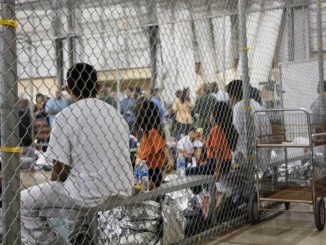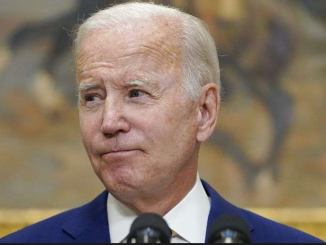
Praise and accolades continue to pour in for the U.S. Capitol Police who defended Congress on Jan. 6, with House Speaker Nancy Pelosi promising to award the force the Congressional Gold Medal.
Across the country in Portland, Oregon, another federal police force is wondering where its medal is.
For nearly a year now, Federal Protective Service (FPS) officers have been defending U.S. government property from attackers who have been every bit as violent as those who stormed the Capitol.
On the scale of mayhem, what’s gone on in Portland is comparable to or worse than Washington. It’s gone on longer, spawned more injuries to law enforcement, and attempted to disrupt a core government function — in this case the judicial branch, which works out of the courthouse.
Yet no praise has issued forth from the halls of Congress.
“Mum’s the word,” said Jeremy Russey, a vice president of the American Federation of Government Employees Local 918, which represents FPS officers. “I feel like everything was so anti-Trump that because we worked under the direction of the president at the time we were kind of lumped under his ‘stormtroopers.’”
FPS is part of Homeland Security, and is charged with providing security at about 9,500 federal locations nationwide. It fields a force of about 1,000 personnel, and contracts with private security companies who provide 15,000 security guards help cover all of the properties.
Over the last year that’s meant dealing with riots from Washington, D.C., to Washington state.
A year’s worth of riots
But Portland has been the most intense, with nightly attacks last summer on the federal Hatfield Courthouse in the city’s downtown area, as well as skirmishes in another part of the city over an office belonging to U.S. Immigration and Customs Enforcement.
Nights would begin with massive racial justice protests, drawing thousands of people, but eventually would morph into a riot with hundreds of demonstrators attempting to assault the courthouse by smashing windows, setting fires and clashing with the federal forces protecting it.
Sometimes they would try to barricade the officers inside, then torch the building, Mr. Russey said.
“The numbers were smaller compared to the Capitol, but the Capitol — it was one night,” he said. “We’re going on almost a year now.”
By at least one measure the FPS was more successful than the Capitol Police. Demonstrators did breach the courthouse grounds, but they never managed to occupy the building the way the pro-Trump Capitol mob did on Jan. 6. No photos of left-wing rioters with feet propped on judges’ desks have emerged from Portland.
That success came with intense scrutiny and criticism.
The city’s mayor told federal forces to pull out, insisting they were causing the violence. A federal judge — ruling from the very courthouse the officers had protected — said some federal officers had gone too far, and he proposed slapping large football jersey-style numbers on their uniforms so the government could police their behavior.
And Mrs. Pelosi, in a July 17 tweet, labeled the officers “stormtroopers” and complained they had overreacted “to graffiti.”
Homeland Security officials said Mrs. Pelosi was underselling the level of violence. They said that, but for the presence of the federal officers, the courthouse would have been razed.
Yet even those Homeland Security officials didn’t offer any commendation to the officers who mounted the defense, said Mr. Russey and Derek Washington, president of AFGE Local 918.
They said the only FPS person to earn commendation out of Portland was a regional director, who was awarded a Quality Step Increase pay raise.
Unprecedented attack
Mrs. Pelosi’s proposal calls for three gold medals to be awarded “to the United States Capitol Police and those who protected the U.S. Capitol on January 6, 2021.” One medal would be displayed at Capitol Police headquarters, one at the city’s Metropolitan Police Department headquarters, and one for the Smithsonian Institution.
The bill also allows the Treasury Department to make and sell duplicates to the public.
The House was poised to take up the bill Monday, but it was postponed.
An attempt to elicit comment from Mrs. Pelosi’s office for this story was unsuccessful.
Rep. Don Beyer, Virginia Democrat, had been slated to preside over the floor debate on the gold medal.
His communications director, Aaron Fritschner, said the medal was being awarded specifically for those who put their lives on the line “to protect the U.S. Capitol from insurrectionists during an attack the FBI has labeled ‘domestic terrorism’ and which was intended to overturn the result of an American presidential election.”
“The events of January 6 represent an unprecedented attack on our democracy, a unique event in our history, and the officers who protected the Capitol that day — including those who lost their lives — deserve special recognition,” Mr. Fritschner said.
But Ken Cuccinelli, who as acting deputy secretary at Homeland Security until Jan. 20 had up-close views of both Portland and the Capitol attack, said the disparate treatment was conspicuous.
“When federal police officers protect against months of left wing assaults, they are Nazi ‘storm troopers’ to Nancy Pelosi, but when federal police officers protect Nancy Pelosi against right of center assault, they are heroes?” Mr. Cuccinelli told The Washington Times. “I think they are all heroes, and I think that will make an excellent amendment to any proposed House resolution.”
He suggested Mrs. Pelosi’s legislation could be amended to honor all the officers who defended U.S. government property over the last year.
Gus Papathanasiou, chairman of the union for Capitol Police officers, said “all of law enforcement needs to be recognized.”
“Support for law enforcement should never be a political issue. We put our lives on the line every single day to serve and protect,” he said.
If Congress does want to show its appreciation in a concrete way, Mr. Russey and Mr. Washington said there’s another step lawmakers could take: Change FPS inspectors’ classification so their pay and retirement are on par with other federal policing agencies.
“I have to work much longer in my job to get the same type of retirement that all of these other federal law enforcement officers, what they have,” Mr. Russey said. “I feel like equal pay for equal work.”
He said FPS officers are leaving the agency to work for other federal police forces, and new hiring can’t keep up.
Others who have responded to the Capitol have been recognized. National Guard troops deployed to Washington in the wake of the Jan. 6 attack can get a brand new “Presidential Inauguration Support Ribbon.”
300 injuries
The disparate treatment of FPS is all the more striking because 16 FPS inspectors also responded to the Capitol on Jan. 6 to help out, according to Mr. Washington, the president of the union local.
Two teams in riot gear joined with Capitol Police to secure the building, with one team on the east front and another inside the Senate wing.
Members of a third team also helped save the life of a man who’d been stabbed on Pennsylvania Avenue, summoning FPS medics who stopped the bleeding and dressed the wounds. The local rescue squad told the FPS personnel the victim would likely have bled to death without the quick response.
In Portland, the defense of the courthouse also saw cooperation by many agencies. At the federal level, the U.S. Marshals Service, a branch of the Justice Department, has had a constant presence, and at the height of mayhem over the summer Homeland Security also deployed agents and officers from Customs and Border Protection (CBP) and Immigration and Customs Enforcement (ICE).
The Capitol Police, whose force is about 2,000 officers strong, say 73 of them were injured in the Jan. 6 attack, according to the New York Times. The Metropolitan Police Department says another 65 of its officers were also injured.
Two Capitol Police officers’ deaths have been tied to the attack.
FPS, meanwhile, has about 1,000 personnel but only about 350 or so actual “gun-toters” that can be deployed across the country. As of mid-February, the union said there were 360 deployments to Portland, including many rotations in and out.
Homeland Security did not provide data on injuries but the union said more than 300 had been reported, including broken bones, burns and eye injuries. Protesters made frequent use of high-powered lasers to try to dazzle officers.
Clashes have also broken out in other cities over the last year, with Seattle a regular hotspot.
And at the height of the demonstrations in early June, one FPS Protective Service Officer — a contract police officer — was shot and killed, and another critically wounded in an attack in Oakland.
Authorities now blame that attack on an agitator from the anti-government fringe “boogaloo” movement, who they say came to Oakland to kill cops. Steven Carrillo is charged with murdering a person assisting an officer or employee of the U.S. government.
*story by The Washington Times


